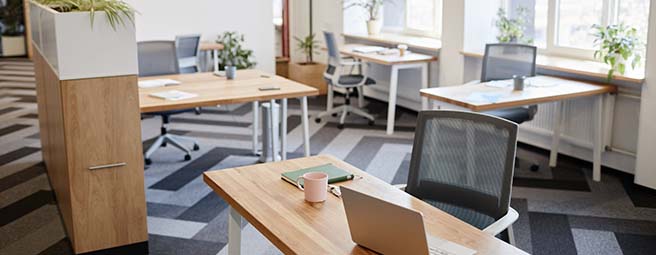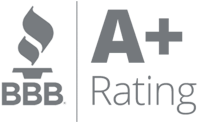
What Is a Flexible Workspace? Flexible Workspace Solutions
The traditional office model—cubicles in rows, assigned desks, and rigid 9-to-5 schedules—no longer fits how modern professionals work. Today's workforce demands environments that adapt to individual needs, support diverse work styles, and accommodate both in-person and remote collaboration. This shift has given rise to flexible workspaces, which are transforming how organizations think about office design and work arrangements.
These dynamic environments prioritize choice and adaptability over fixed layouts and static assignments. This post defines flexible workspaces, explores their key characteristics, compares remote work to flexible work, and examines how businesses and employees benefit from these solutions.
What Is a Flexible Workspace?
A flexible workspace is a dynamic, adaptable office environment designed to accommodate various work styles, schedules, and tasks rather than assigning static desks or rigid layouts. These spaces prioritize choice, allowing individuals and teams to select environments matching their immediate needs—whether collaboration, focused work, or informal meetings. Unlike traditional offices where each employee occupies the same desk daily, flexible workspaces offer multiple options within a single location. An employee might start the morning in a quiet focus zone, move to a collaboration area for a team brainstorming session, and finish the day in a private booth for client calls.
Flexible workspaces typically include hot desks and shared workstations where employees work on a first-come, first-served basis or through reservation systems. Private offices and meeting rooms remain available for confidential discussions, while quiet zones are designed with acoustic treatment for deep focus work. Open collaboration areas feature comfortable seating arrangements and whiteboards that encourage teamwork, and communal spaces like kitchens and lounges provide places where employees recharge and build connections. Technology-enabled conference rooms come equipped with video conferencing capabilities, ensuring remote team members can participate fully.
Beyond physical design, flexible workspaces operate differently than traditional offices. Short-term leases or membership models replace multi-year commitments, allowing organizations to adjust quickly. Pay-for-what-you-use pricing structures mean companies only pay for space actually utilized rather than maintaining expensive unused square footage. The ability to scale up or down based on team size supports business growth without real estate constraints. Support for hybrid and remote work arrangements provides infrastructure whether employees work on-site, remotely, or split time between locations.
Key Characteristics of a Flexible Workspace
Five defining characteristics separate flexible workspaces from conventional offices, creating environments that respond to modern work demands rather than forcing workers into outdated models.
1. Adaptability
Adaptability is the hallmark of flexible workspaces. Modular furniture and movable partitions allow rapid reconfiguration without construction—a large open area might become four separate team spaces in hours. When a company shifts from individual contributors to project-based pods, the workspace adapts accordingly. The same space might host a workshop in the morning and provide quiet workstations in the afternoon. Technology infrastructure supporting various work functions remains available regardless of how the physical space is configured. This adaptability extends beyond furniture to lighting adjustments, acoustic modifications, and temperature controls.
2. Variety
Variety recognizes that different tasks require different environments. Open-plan areas facilitate spontaneous collaboration while private spaces offer refuge for concentration. A range of seating options—standing desks, lounge seating, traditional desks, bar-height tables—accommodates individual preferences. Different acoustic environments address varying concentration requirements, with some employees thriving with background energy while others require near-silence. This variety matters because knowledge work isn't uniform—writing code demands different conditions than conducting performance reviews or brainstorming marketing campaigns.
3. Scalability
Scalability accommodates business fluctuations without long-term commitments. Organizations can add desks, offices, or entire floors as teams grow without negotiating new leases. Seasonal workforce changes align costs with actual headcount rather than maintaining year-round capacity for peak periods. Startup growth trajectories benefit particularly from this characteristic, as a five-person team today might become fifty people next year. Project-based team scaling allows companies to bring in contractors with access to professional workspace without permanent overhead.
4. On-Demand Hybrid Work Support
On-Demand Hybrid Work Support enables seamless integration of in-office and remote work. Technology ensures remote participants engage fully in meetings rather than being afterthoughts watching from laptop screens. Booking systems let employees secure workspace when planning to come on-site without maintaining permanently assigned desks. Resources remain accessible whether employees work on-site or remotely, with cloud-based systems meaning location doesn't limit capability. This characteristic recognizes that hybrid work isn't a temporary adjustment but a permanent feature of modern work arrangements requiring purpose-built support.
5. Amenities
Amenities make flexible workspaces genuinely appealing compared to alternatives. High-speed internet and reliable connectivity are basics, but flexible workspaces typically provide enterprise-grade infrastructure with redundancy and security. Ergonomic furniture prevents the injuries that can result from improvised home office setups. Shared office supplies and equipment eliminate purchase and maintenance needs. Professional reception and mail services create credibility for growing businesses. Wellness facilities might include fitness areas, meditation rooms, or outdoor spaces. Community events and networking opportunities add value beyond desk access, creating connections that can lead to collaborations or new business relationships.
What Is an Example of a Flexible Workforce?
A flexible workforce consists of employees who have autonomy over how, when, and where they complete their work based on job responsibilities and personal needs. This differs from flexible workspace—focusing on people and policies rather than physical environments.
Remote Work Models
Remote work models allow employees to work from anywhere. LinkedIn enables the majority of its workforce to operate remotely, providing access to global talent while reducing real estate costs. Fully distributed companies like GitLab build entire operations around remote collaboration, demonstrating that even complex product development can occur without shared physical space.
Hybrid Work Arrangements
Hybrid work arrangements blend in-office and remote work. Amazon requires employees to work in-office three days weekly with remaining days remote, maintaining regular in-person connection while providing flexibility. Salesforce allows team managers to determine attendance frequency based on team needs rather than company-wide mandates. These models recognize that some work benefits from physical presence—onboarding, complex problem-solving, team cohesion—while other work happens effectively anywhere with flexible workspace solutions.
Flextime Schedules
Flextime schedules let employees choose start and end times matching their peak productivity. Dell has maintained flextime policies for years, with one employee working 7 AM to 3 PM while another works 10 AM to 6 PM. This improves work-life integration by accommodating personal responsibilities and respecting individual chronotypes. Productivity often increases when people work during their highest-energy periods.
Compressed Workweeks
Compressed workweeks maintain full-time hours but condense them into fewer days. Buffer and Basecamp have implemented four-day workweeks, with employees working longer days Monday through Thursday and taking three-day weekends. This model exchanges daily flexibility for extended recovery time, with many organizations reporting maintained or improved performance despite fewer working days.
Job Sharing and Annualized Hours
Job sharing and annualized hours allow two employees to split one full-time position or let hours vary throughout the year based on business cycles. These arrangements accommodate diverse life circumstances—parents seeking reduced hours, employees pursuing education, or individuals managing health conditions—while maintaining professional engagement.
Remote Work vs Flexible Work: Understanding the Difference
Many people use "remote work" and "flexible work" interchangeably, but they represent distinct concepts. Understanding this difference clarifies what flexible workspace solutions actually provide.
Remote work means performing job duties outside a traditional office setting, typically from home or other non-office locations. The defining characteristic is location—work happens away from a central company office. However, remote work may still follow fixed schedules. A remote employee might be required to work 9 AM to 5 PM, participate in scheduled meetings, and maintain traditional work hours despite being physically distant from colleagues. The primary benefit centers on location independence and commute elimination.
Despite significant advantages, remote work alone doesn't address all flexibility needs. Home environments can lack structure or designated workspace. Potential isolation from team members affects some employees negatively. Remote work addresses where work happens but may not change when or how work occurs. Distractions at home—children, pets, deliveries—can undermine productivity benefits.
Flexible work encompasses autonomy over where, when, and how work is completed, representing a broader concept than remote work alone. This approach includes remote work as one option but extends to schedule flexibility, workspace variety, and personalized work methods. An employee might have flexibility to work remotely three days weekly, use hot desks when in-office, adjust hours for personal commitments, and select collaboration spaces matching their tasks. The emphasis shifts to employee agency and choice rather than simply changing the location of traditional work patterns.
Flexible work arrangements include flextime, compressed schedules, part-time arrangements, physical workspace flexibility, and task-based flexibility focusing on outcomes rather than presenteeism. This broader scope recognizes that optimal work arrangements vary by individual, role, and situation.
|
Aspect |
Remote Work |
Flexible Work |
|
Primary Focus |
WHERE you work |
WHERE, WHEN, and HOW you work |
|
Location Options |
Home, cafe, anywhere outside office |
Multiple options including office variety |
|
Schedule |
May still be fixed (9-5) |
Often includes flextime or compressed weeks |
|
Workspace Variety |
Limited to chosen remote location |
Access to multiple workspace types |
|
Autonomy Level |
Location independence only |
Comprehensive work condition control |
|
Example |
Working from home 9 AM - 5 PM daily |
Choosing office/home, adjusting hours, selecting workspace types |
[heading] Remote Work vs. Flexible Work
Remote work represents one dimension of flexible work—a component within the larger framework rather than a synonym. Flexible workspace solutions provide infrastructure enabling various arrangements, including remote work, while offering additional options. An employee with flexible work options might work remotely Monday and Friday, come to the office Tuesday through Thursday using hot desks, adjust hours to start early some days and later others, and choose quiet focus zones when doing complex analysis and open areas when working on projects benefiting from team input. This arrangement provides comprehensive flexibility rather than simply working from home.
Flexible Workspace Solutions: Meeting Modern Needs
Organizations require practical solutions for implementing flexible workspace concepts. Various models have emerged, each addressing different organizational needs.
Coworking Spaces
Coworking spaces provide shared environments where multiple companies work alongside each other. Davinci Meeting Rooms and similar providers offer full amenity access—high-speed internet, meeting rooms, printing services—without facility management burdens. Networking opportunities across industries represent an often-undervalued benefit. Scalable membership options let organizations start with a few desks and expand as teams grow. Month-to-month or annual terms replace five and ten-year leases. Coworking works particularly well for startups, small businesses, and remote teams needing occasional shared space.
Serviced Offices
Serviced offices provide private offices within flexible buildings, combining dedicated space with flexible terms and included services. Organizations get their own lockable office space while operating within buildings offering shared amenities like reception and meeting rooms. Professional support services—mail handling, call answering, administrative assistance—are typically included. Lease terms remain shorter than traditional offices, usually ranging from months to a few years. Ready-to-use infrastructure means companies move in immediately with everything operational from day one.
Activity-Based Working Environments
Activity-based working environments are designed within company-specific facilities, organized around task types rather than individuals. Different zones support different work modes: deep focus areas, collaboration spaces, informal meeting zones, private call rooms, and social areas. Employees choose locations based on current activities rather than sitting in assigned seats all day. Technology platforms typically support these environments, allowing employees to book desks or rooms and access analytics on space utilization.
On-Demand Meeting Rooms
On-demand meeting rooms address occasional professional space needs without long-term commitments. Davinci Meeting Rooms offers access to professional conference rooms in multiple locations on an as-needed basis. These solutions work particularly well for consultants, sales professionals, and remote-first companies needing impressive professional spaces occasionally rather than constantly.
Choosing the Right Solution
Small businesses and startups typically benefit from coworking or serviced offices, minimizing upfront investment while providing professional environments and scalability. Established firms may adopt hybrid models to cut real estate costs but keep some conventional office space. Fully remote organizations utilize on-demand spaces for occasional in-person needs while potentially providing distributed flexible workspace access. The optimal solution often combines multiple approaches—a company might maintain activity-based headquarters, offer coworking memberships in secondary markets, and provide access to on-demand meeting rooms for client-facing employees.
Benefits of Flexible Workspaces
Flexible workspaces deliver measurable advantages for both organizations and their employees. Understanding the high-level advantages clarifies why flexible workspace adoption continues accelerating.
Benefits for Businesses
Cost efficiency represents an immediate advantage. Organizations pay only for space and services actually used rather than maintaining expensive unused square footage. A company with 50 employees working hybrid schedules might need only 30-35 desks instead of 50 dedicated workstations, immediately reducing costs. Lower maintenance and facility management expenses shift to workspace providers who achieve economies of scale. Companies focus capital on their core business rather than managing office logistics.
Business agility increases when real estate decisions don't constrain strategic options. Rapid response to growth or contraction needs allows companies to seize opportunities or adjust to market changes. Easy expansion into new markets becomes possible without major commitments—testing a new city with a few coworking desks involves minimal risk. Quick adaptation to changing team structures supports organizational evolution. Freedom from rigid real estate decisions made years earlier liberates strategic planning.
Enhanced collaboration and innovation flows from workspace design intentionally supporting different types of interaction. Diverse spaces foster everything from formal structured meetings to spontaneous hallway conversations that often generate breakthrough ideas. Cross-pollination of ideas in shared coworking environments exposes employees to different industries and thinking patterns. Environments designed specifically for teamwork make collaboration easier and more productive.
Talent attraction and retention improves when organizations offer work arrangements candidates increasingly expect. Modern work arrangements appeal to top candidates who prioritize flexibility in employment decisions. Flexibility serves as a competitive differentiator in hiring markets. Reduced turnover follows improved satisfaction, with employees less likely to leave when they have autonomy over work conditions. The cost of replacing departed employees—typically 50-200% of annual salary—makes retention improvements highly valuable.
Benefits for Employees
Autonomy and choice affect daily work experience and satisfaction. Control over work environment selection empowers employees to optimize their productivity. The ability to match space to task requirements means employees can seek quiet for concentration-demanding work and open areas for collaboration. Empowerment through decision-making capability extends beyond workspace to influence overall job satisfaction, with autonomy consistently correlating with higher engagement.
Work-life integration improves when flexibility accommodates the reality that professional and personal life coexist. Reduced or eliminated commute times return hours weekly to employees, reducing stress and providing time for exercise, family, or rest. Better accommodation of personal responsibilities reduces the stress of balancing competing demands. Greater control over daily schedules allows people to work during their highest-energy periods and manage energy rather than simply enduring rigid schedules.
Enhanced productivity results from environments specifically designed to support effective work. Environments optimized for different work types ensure each task happens in appropriate settings. Ergonomic furniture and a proper setup reduce physical discomfort. Fewer distractions than home offices matter for many employees, particularly those in shared housing or with young children. Technology infrastructure supporting efficient work eliminates the frustration of inadequate home office equipment.
|
Category |
Business Benefits |
Employee Benefits |
|
Financial |
Pay only for space used, lower overhead, reduced facilities costs |
Reduced commute expenses, professional workspace access, premium amenities |
|
Operational |
Rapid scaling, market expansion flexibility, no long-term constraints |
Choose optimal environment, match space to task, control over conditions |
|
People |
Attract top talent, improved retention, global workforce access |
Improved work-life balance, reduced stress, greater autonomy |
|
Performance |
Enhanced collaboration, faster adaptation, innovation-friendly spaces |
Higher productivity, better focus options, ergonomic comfort |
[heading] Business and Employee Benefits from Flexible Workspaces
For comprehensive exploration of specific benefits, implementation strategies, real-world examples, and detailed analysis of cost savings and productivity improvements, see this in-depth examination of flexible office space benefits.
Future of Flexible Workspaces
Flexible workspaces represent a fundamental shift in how organizations and individuals approach work environments, prioritizing choice, efficiency, and employee well-being over rigid traditional models. These dynamic environments are defined by five key characteristics: adaptability allowing rapid reconfiguration, variety providing options for different work modes, scalability aligning costs with actual needs, on-demand hybrid work support enabling seamless distributed collaboration, and comprehensive amenities that make these spaces genuinely appealing.
Flexible workforce examples—from remote work models to hybrid arrangements, flextime schedules, and compressed workweeks—demonstrate real-world implementation across industries. Understanding that remote work and flexible work represent related but distinct concepts clarifies what flexible workspace solutions actually provide. Remote work addresses where work happens, while flexible work encompasses broader autonomy over where, when, and how work is completed.
Solutions ranging from coworking spaces and serviced offices to activity-based working environments and on-demand meeting rooms address different organizational needs. Benefits extend powerfully to both businesses and employees. Organizations gain cost efficiency, business agility, enhanced collaboration, and improved talent attraction. Employees experience greater autonomy, improved work-life integration, and enhanced productivity.
As work continues evolving, flexible workspace solutions will become standard rather than exceptional. Organizations embracing this shift position themselves for long-term success by aligning workspace strategy with how work actually happens in modern knowledge economies. Evaluate current workspace arrangements against the characteristics outlined here. Consider whether flexible solutions might better serve organizational goals and employee needs. The evidence increasingly suggests that flexibility in workspace isn't a temporary trend but a permanent evolution in how successful organizations operate.
Frequently Asked Questions
1. How much does a flexible workspace cost compared to a traditional office?
Flexible workspace costs vary by location, provider, and services included, but most organizations save 30%-70% compared to traditional office leases. Coworking desks typically range from $200-$800 per person monthly, while serviced offices cost $500-$1,500 per person monthly. Traditional offices require not only lease payments but additional expenses for utilities, furniture, maintenance, internet, reception staff, and cleaning services—all typically included in flexible workspace pricing. The pay-as-you-go model means you only pay for occupied desks rather than maintaining empty space during slow periods or between growth phases. Hidden cost savings include reduced buildout expenses, no long-term lease penalties when downsizing, and elimination of facility management overhead.
2. What industries benefit most from flexible workspaces?
While flexible workspaces serve virtually every industry, certain sectors see particularly strong advantages. Technology and software companies benefit from the ability to scale rapidly without real estate constraints. Consulting firms and professional services appreciate on-demand meeting rooms for client presentations without maintaining expensive permanent offices. Creative agencies thrive in collaborative coworking environments that foster innovation and cross-pollination of ideas. Startups across all industries minimize capital requirements while maintaining professional credibility. Remote-first companies in fields like marketing, design, and content creation use flexible workspaces to provide employees with professional environments beyond home offices. Even traditional industries like finance, legal services, and healthcare increasingly adopt flexible solutions for satellite offices, temporary project teams, or hybrid work programs.
3. Can large enterprises use flexible workspaces effectively?
Absolutely. Large enterprises increasingly incorporate flexible workspaces into their real estate strategies, though their approach differs from startups. Many Fortune 500 companies maintain traditional headquarters while using flexible workspaces for satellite offices, regional presence, temporary project teams, or overflow capacity during peak periods. Enterprise-specific solutions include private floors within flexible buildings, custom-branded spaces, and dedicated amenities while retaining flexible terms. Large organizations use flexible workspaces to test new markets before committing to traditional leases, accommodate merger and acquisition integration, and support distributed teams.
4. How do flexible workspaces handle security and confidentiality concerns?
Reputable flexible workspace providers implement multiple security layers to protect member privacy and data. Physical security typically includes keycard or biometric building access, 24/7 security personnel or monitoring, private lockable offices for confidential work, and secure Wi-Fi networks with enterprise-grade encryption. Many providers offer private office suites completely separated from shared coworking areas for companies with strict confidentiality requirements. IT security features include dedicated secure networks separate from guest Wi-Fi, VPN compatibility for remote secure access, and compliance with industry standards like SOC 2, ISO 27001, or HIPAA for regulated industries. Organizations handling highly sensitive information can request dedicated internet connections, private server rooms, or enhanced security protocols. Meeting rooms typically include soundproofing and privacy features, and many providers offer non-disclosure agreements for staff members who might access member spaces.
5. What happens if my company outgrows a flexible workspace?
One of flexible workspaces' greatest advantages is seamless scalability without the disruption of traditional office moves. Most providers offer expansion options within the same building, allowing you to add desks, offices, or entire floors as your team grows. If you outgrow a single location, many providers operate multiple buildings in the same city, letting you add satellite locations while maintaining your original space. When companies grow beyond flexible workspace capacity entirely, they often maintain some flexible workspace presence for satellite teams, temporary projects, or specific functions while moving core operations to traditional space. The flexibility works both directions—if business contracts, you can reduce your footprint without lease penalties or being trapped in expensive unused space.
Related Resources
10 Flexible Workspace Examples & How They Work
https://www.davincimeetingrooms.com/blog/10-flexible-work-spaces
Coworking Space vs. Flexible Workspace: What's the Difference?
https://www.davincimeetingrooms.com/blog/what-is-flex-space-how-it-compares-to-coworking-spaces
Rise of the Flexible Workspace Industry
https://www.davincimeetingrooms.com/blog/rise-of-the-flexible-workspace-industry
Who Uses Coworking Spaces: 26 Professionals Who Thrive in Shared Workspaces
https://www.davincimeetingrooms.com/blog/who-uses-coworking-spaces
12 Questions to Ask Your Employees About Flexible Working
https://www.davincimeetingrooms.com/blog/12-questions-about-flexible-working

Categories
Subscribe to Our Blog
Archive

- November 2025
- October 2025
- September 2025
- August 2025
- July 2025
- June 2025
- May 2025
- April 2025
- March 2025
- February 2025
- January 2025
- December 2024
- November 2024
- October 2024
- September 2024
- August 2024
- July 2024
- June 2024
- May 2024
- April 2024
- March 2024
- February 2024
- January 2024
- December 2023
- November 2023
- October 2023
- September 2023
- August 2023
- July 2023
- June 2023
- May 2023
- April 2023
- March 2023
- February 2023
- January 2023
- December 2022
- November 2022
- October 2022
- September 2022
- August 2022
- July 2022
- June 2022
- May 2022
- April 2022
- March 2022
- February 2022
- January 2022
- December 2021
- November 2021
- October 2021
- September 2021
- August 2021
- July 2021
- June 2021
- May 2021
- April 2021
- March 2021
- February 2021
- January 2021
- December 2020
- November 2020
- October 2020
- September 2020
- August 2020
- July 2020
- June 2020
- May 2020
- April 2020
- March 2020
- February 2020
- January 2020
- December 2019
- November 2019
- October 2019
- September 2019
- August 2019
- July 2019
- June 2019
- May 2019
- April 2019
- March 2019
- February 2019
- January 2019
- December 2018
- November 2018
- October 2018
- September 2018
- August 2018
- July 2018
- June 2018
- May 2018
- April 2018
- March 2018
- February 2018
- January 2018
- December 2017
- September 2017
- June 2017
- April 2017
- October 2016
- July 2016
- May 2016
- April 2016
- February 2016
- November 2015
- September 2015
- February 2015
- January 2015
- December 2014
- November 2014
- October 2014
- August 2014
- July 2014
- July 2013
- May 2013
- February 2013
- December 2012
Talk to an expert
Want help finding the ideal meeting room? Give us a call
Book the Perfect Meeting Room Now
Find a Meeting Room








